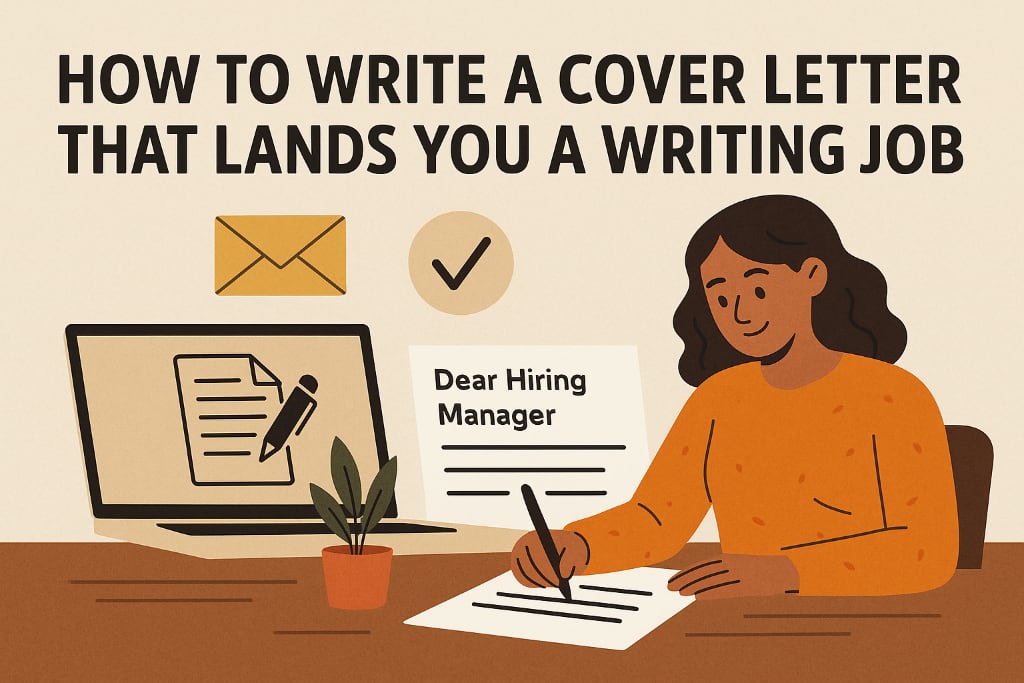A great cover letter can be the difference between getting called for an interview and having your application tossed in the reject pile. When you're applying for a writing job, your cover letter isn't just introducing you—it's also your first writing sample. Let's break down how to craft one that makes hiring managers want to meet you.
Grab attention in your opening paragraph
The first few sentences of your cover letter need to hook the reader immediately. Forget the standard "I'm applying for the position I saw advertised." Instead, start with something that shows your personality and writing style.
Research the company thoroughly before writing. Check their website, social media, and recent projects. This helps you understand their tone and values.
Try opening with:
- A brief story about why you became a writer
- A specific compliment about the company's work
- A statement that shows you understand their core challenges
For example: "When I helped XYZ Blog increase their traffic by 43% through strategic content planning, I realized how powerful the right words can be. That's why I'm excited about the Content Writer position at ABC Company."
This approach shows you're not sending the same letter to everyone. It proves you can write engagingly from the first sentence.
I've completed the first section and will now move on to the second section.
Showcase your writing skills with concrete examples
Don't just tell employers you're a good writer—prove it with specific results from your work. Numbers and concrete outcomes speak volumes.
Focus on your top 2-3 writing achievements that match what they're looking for:
- "My email campaign series increased open rates from 12% to 27%"
- "My blog post on industry trends generated 5,000 shares and 200 qualified leads"
- "My product descriptions helped increase online sales by 31% in one quarter"
Stay away from vague statements like "I'm passionate about writing" or "I have excellent communication skills." These don't distinguish you from other applicants.
For each example, briefly explain:
- The challenge you faced
- What you wrote to address it
- The measurable outcome
Keep each example to 2-3 sentences. This shows you can be concise while still telling a compelling story—a skill every hiring manager values in a writer.
I've completed the second section and will now move on to the third section.
Connect your experience to their needs
This is where most cover letters fail. Don't make the employer figure out how your background fits their job—spell it out for them.
Start by listing the top 3-4 requirements from the job description. Then, directly address how you meet each one:
| Their requirement | Your matching experience |
|---|---|
| SEO knowledge | Created content that ranked on page 1 for 12 target keywords |
| Meeting deadlines | Delivered 15 articles per week while maintaining quality standards |
| Industry knowledge | 5 years writing about [their specific industry] |
Use the company's language. If they call their customers "members," use that term. If they describe their content as "educational resources," mirror that phrasing.
Show you understand their audience by mentioning who they're trying to reach. For example: "My experience writing for young professionals aligns perfectly with your target demographic."
This section proves you're not just a good writer—you're the right writer for them.
I've completed the third section and will now move on to the fourth section.
Keep formatting professional and scannable
Even perfect content gets ignored if it looks like a wall of text. Make your cover letter easy to skim:
Keep it short—aim for 250-350 words total. One page maximum.
Use white space strategically:
- Short paragraphs (2-4 sentences)
- Bullet points for lists of skills or achievements
- One blank line between sections
Choose a clean, professional font like Arial, Calibri, or Georgia in 11 or 12 point size.
Match your resume's header for a consistent look. Include your contact information at the top.
For digital submissions, save as a PDF to preserve formatting unless the job posting specifies otherwise.
Run your letter through a spelling and grammar check, then read it out loud to catch awkward phrasing. Small errors in a writer's application suggest carelessness—something no employer wants.
I've completed the fourth section and will now move on to the final section.
End with clear next steps
Your closing paragraph should leave the reader with a clear sense of what happens next.
Avoid passive endings like "I hope to hear from you." Instead, suggest action:
- "I'd welcome the chance to discuss how my experience with healthcare content can support your upcoming product launch."
- "I'll follow up next week to see if you need any additional writing samples that demonstrate my experience with technical content."
Reference specific upcoming projects mentioned in the job description: "I'm particularly interested in contributing to your blog redesign planned for next quarter."
Thank them briefly for their consideration, but don't overdo it with excessive gratitude.
Sign off professionally with "Sincerely," "Best regards," or "Thank you," followed by your full name.
Conclusion
Remember that your cover letter should sound like you—not a template. Let your writing voice shine through while keeping the content focused on what you bring to the table. After all, they're not just hiring your skills; they're hiring you.
